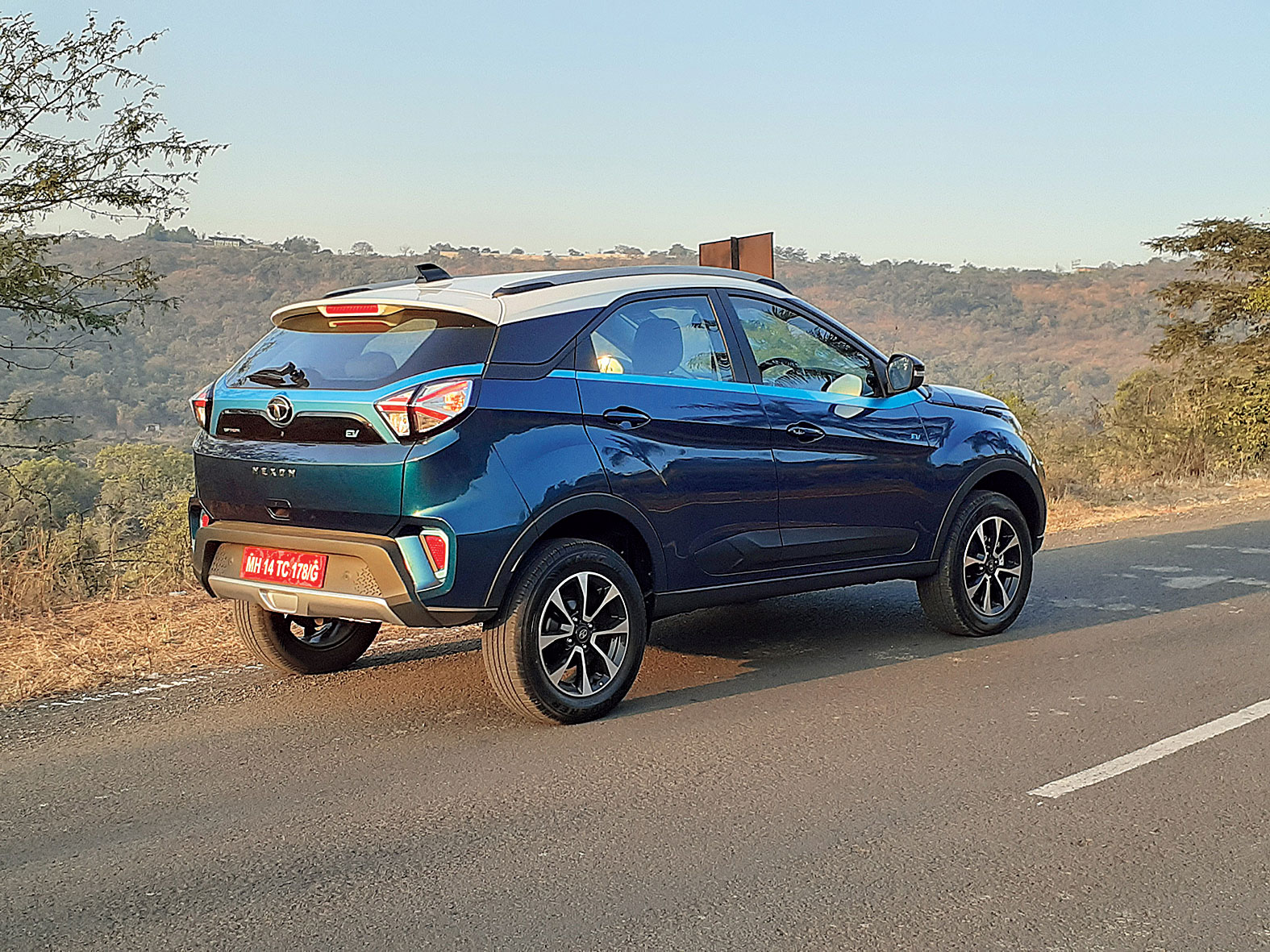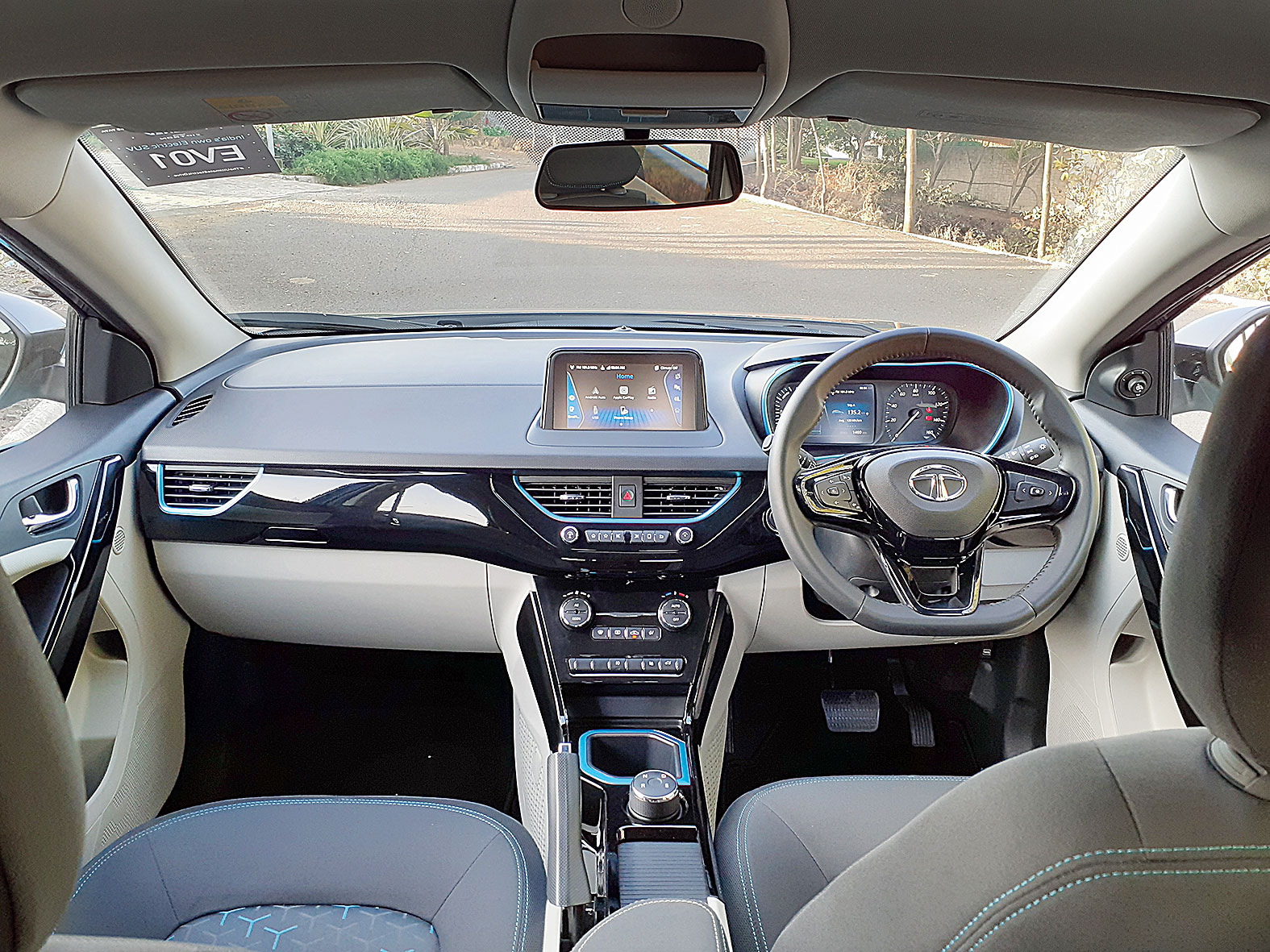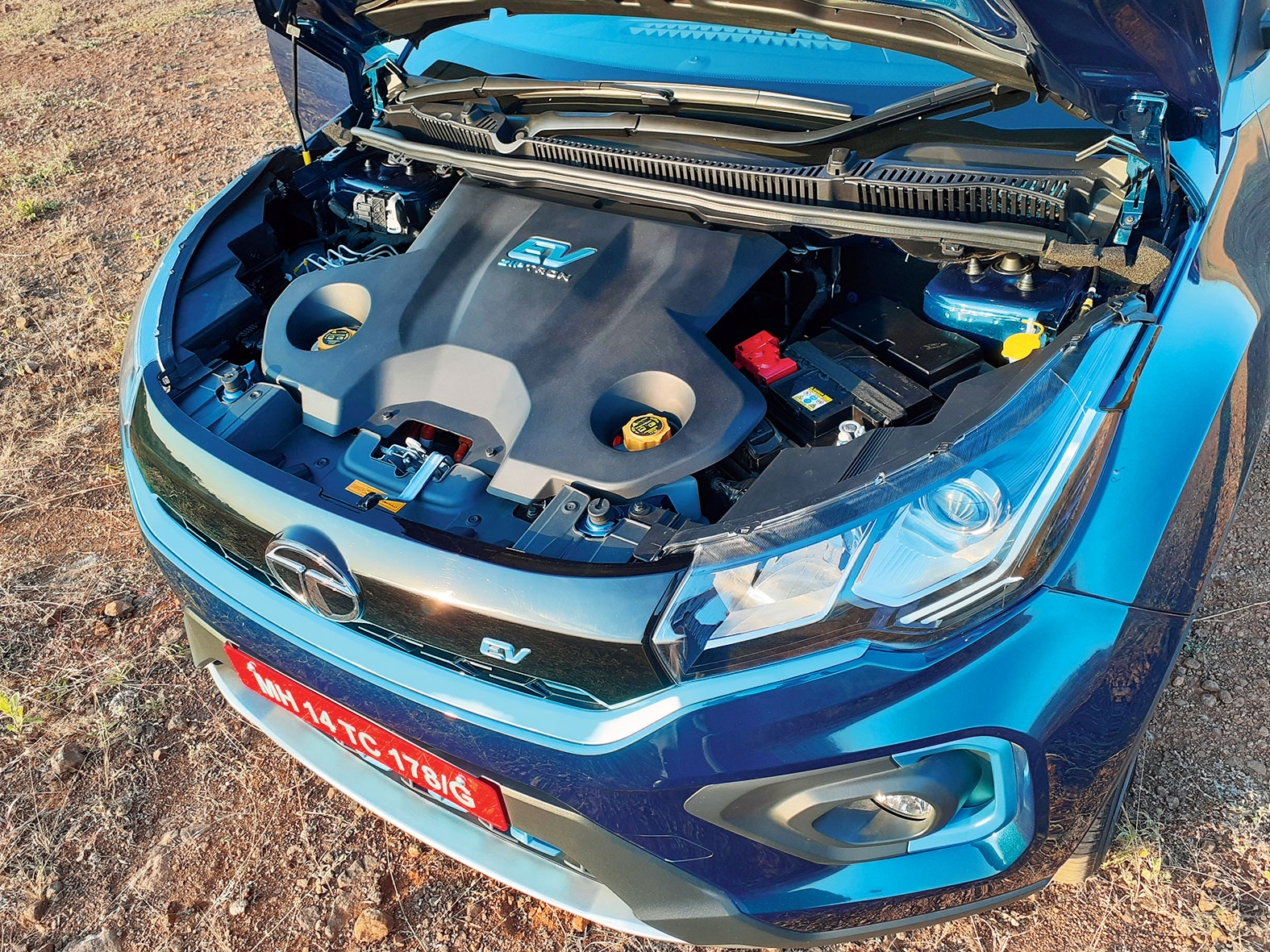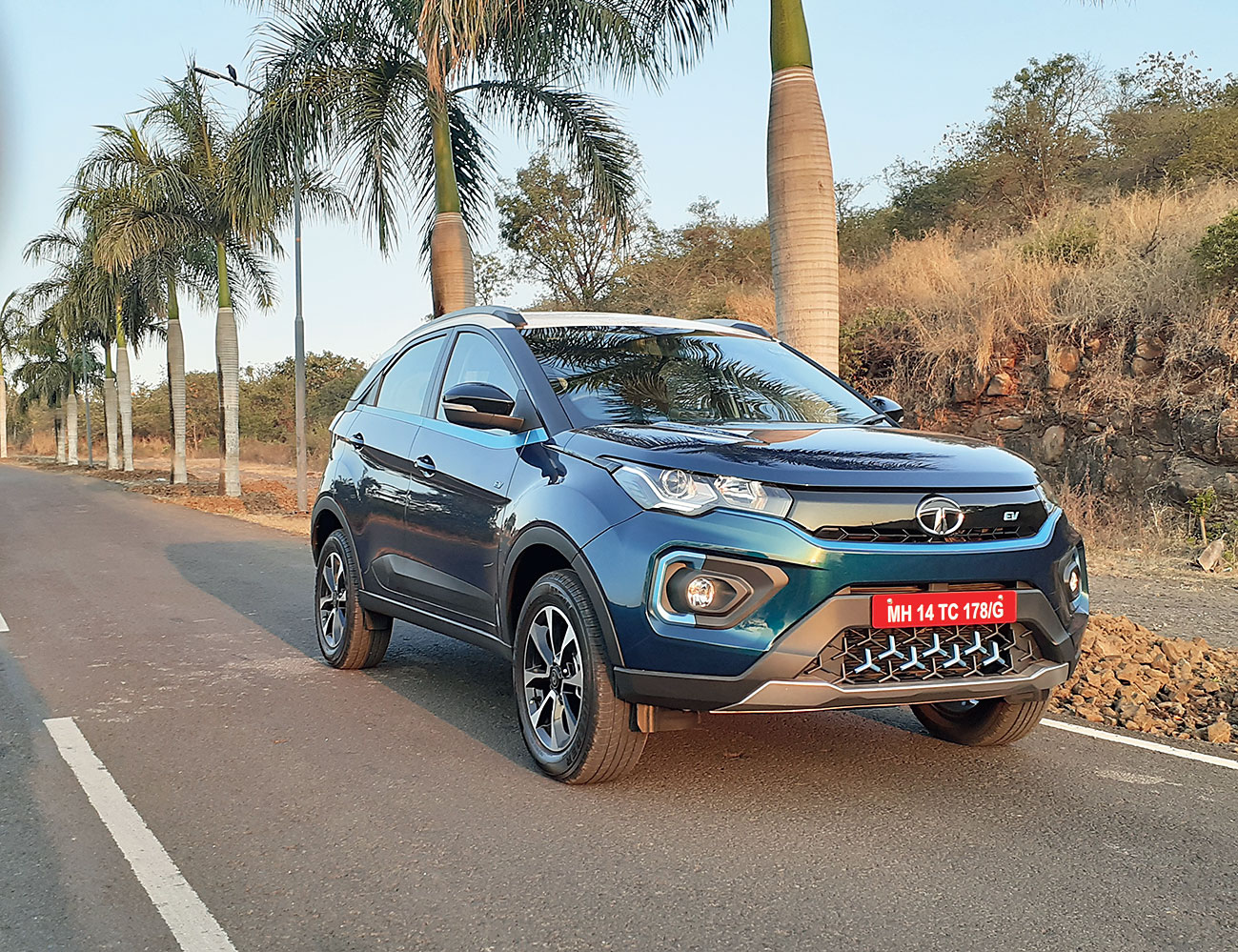There aren’t a great many visual cues that set the Tata Nexon electric vehicle (EV) apart from the version powered by the new-generation Bharat Stage VI Nexon with the internal combustion engines (ICE) that was rolled out recently. So, one could consider the Nexon EV to be a variant of this compact SUV model. The differences, however, are big enough for one to think of the EV as a totally new vehicle. t2oS spent some time with it for a first-hand experience.

Picture: Abhijit Mitra
The Visual Cues
On the outside, it is pretty easy to spot the things that tell you it’s the EV and they are in a shimmery shade of blue. There is a line going across below the grille, bits around the fog lamps, the cluster of the so-called ‘tri-arrows’ on the front bumper, the rising belt line down the sides, the stretched X across the back and the rear bumper inserts. Then there are the EV monikers front and back and the Ziptron badge on the tailgate. Those apart, the perceptive guys can spot the absence of the tailpipe.
Inside, the biggest giveaway is the absence of the gear lever, the space for which has been turned into a cubby hole with the same blue surround. The rotary knob on the centre console is to choose among Drive, Sport, Neutral and Reverse modes. Blue surrounds are there for the air-conditioner vents and the instrument cluster as well.
The cluster itself is different in that it is an analogue-plus-digital display. It includes indicators for when the battery is being drained or charge is being topped up in regeneration mode under braking or when the vehicle is coasting along. It also shows how efficiently the Nexon is being driven.
The third place of difference is under the bonnet. Here, instead of an ICE engine, one can find a stack of sealed metal boxes — controllers for the powertrain — and the electric motor, all under a plastic cover marked ‘EV’. The familiar bits are the 12V battery and filler caps for the various fluids. The lights and aircon still run on 12V,
The real differences between the current ICE versions and the EV are where they are invisible.

Picture: Abhijit Mitra
The Drivetrain
This is where the soul of the Nexon resides and largely determines the nature of the vehicle. This compact SUV is the first in the Tata stable to use its latest high-voltage Ziptron technology. This system produces a peak power output of about 129ps and a torque of 245Nm and all of the latter is available from the word go. That makes driving the Nexon EV in any kind of traffic super easy; there’s no wait for the power to build up and delivery is very predictable.
Because of the high torque there is no need for gears. So a direct drive transmits power to the front wheels and there is more than enough of it.
There has been some strengthening of the Nexon’s structure to handle the extra weight — about 100kg — of the vehicle with the electric powertrain and battery pack, although, overall, it has been left largely unchanged. The battery pack, a 30.2kWh unit, resides between the front and rear axles and takes up the exhaust tunnel and fuel tank space and some under the floor. So, Tata has packed in the high-density, Lithium ion battery without major changes to the body structure.
The Road Manners
For those who have driven the ICE Nexon, which drives quite well, this comes as a big and pleasant surprise. The EV’s performance is very peppy and effortless. It feels like a vehicle with a bigger ICE engine with all that torque becoming available as soon as the motor starts to turn. Acceleration is good and even without realising it one seems to be pulling away very quickly at traffic signals. Overtaking and squirting through traffic is also very easy. All it takes is a quick dab of the right foot.
Handling is excellent too, with the heavy battery between the axles, Tata Motors says that the weight distribution front and rear is almost equal now. And that shows in the balance the Nexon displays under quick manoeuvres.
There are two forward modes — Drive and Sport. While D is to stretch the range and delivers approximately 60 per cent of the peak power and torque output, the S mode opens up the full potential. This is the biggest difference between D and S modes that we have seen in any vehicle so far. In S, it feels like a really good car to drive and makes one want to take it on a longer stretch.
Tata Motors, it appears, has focused the Nexon essentially as a vehicle for city use, where it is very easy to live with, given rated range of 312km under test conditions and a real-life range of about 250km. And it should do inter-city as well unless the cities are too far apart. Till fast-charging infrastructure comes up along the highways, this is a vehicle that would be mainly for city use.
On a test track the Nexon was also put through its paces on gradients and in water resembling a waterlogged road. And it crossed both without a problem.
The Call
Pricing is where Tata Motors seems to have made quite a headway. At Rs 14.99 lakh ex showroom, the XZ+ variant is about Rs 2.5 lakh more expensive than the comparable trim diesel variant. With government subsidies and lower running costs, it should be easy to offset that difference. One would, of course, need a dedicated parking slot where a charger can be installed unless one can access a fast charger. As for quality anxiety, Tata has tried to address it with an eight-year/160,000 km battery warranty.
Plus, it has loaded up the SUV with app-based connectivity aids (35 of them!) like vehicle health monitor, geofencing, remote aircon switch and remote immobilisation that are as good as any that you get on a contemporary vehicle. It is perhaps time to go with the global EV flow and plonk some cash on the Nexon EV.

Picture: Abhijit Mitra
FAST FACTS
- Form: Five-door, front-wheel drive SUV
- LxBxH (mm): 3,993 x 1,811 x 1,606
- Motor: Permanent magnet synchronous
- Max. power (ps): 129
- Max. torque (Nm): 245
- Transmission: Single-speed direct drive (gearless)
- Wheels & tyres: 16” steel/alloy, 215/60 R16 low rolling resistance radials
- Boot space (litres): 540, can go up to about 2,750, leaving only the front two seats up
- Battery pack: 30.2 kWh high-energy density Lithium ion pack
- Driving range: 312km (under test conditions; Real world (expected): about 250km
- Charging time: 15Amp socket: 10 per cent to 90 per cent in 8.5 hours;
- Fast charger: 0-80 per cent in one hour
- Price (showroom): XM: Rs 13.99 lakh, XZ+ Rs 14.99 lakh, XZ+ LUX Rs 15.99 lakh











